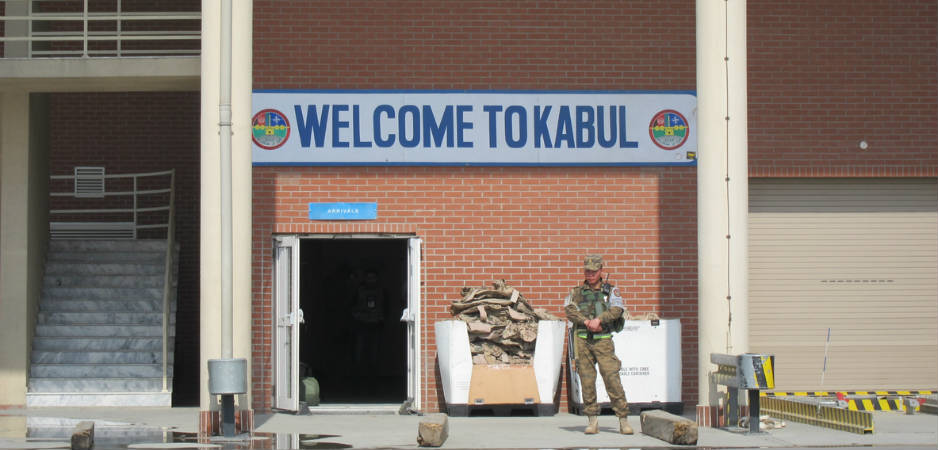Afghanistan’s regional policy is not constructed around local rivalries.
On December 4, the Sixth Ministerial Conference of the Heart of Asia-Istanbul Process was held in Amritsar, India. The Heart of Asia process was launched in 2011 as a new and complementary framework for enhancing dialogue and consensus for regional cooperation and stability.
In his opening remarks at the conference, Afghan President Mohammad Ashraf Ghani reiterated that regional connectivity, development and counterterrorism are inevitable measures for the future stability of Afghanistan and the Heart of Asia region as a whole.
As the center of the Heart of Asia, Afghanistan has the potential to serve as a hub of connectivity between China, Central Asia, the Middle East and South Asia. As a crucial part of the ancient Silk Road, Afghanistan is trying to restore its historical position to play a substantive role in regional stability and connectivity. Challenges such as terrorism, radicalization as a sociopolitical process, bilateral rivalries and economic fragmentation are undermining the future revival of the Silk Road.
As such, any cooperation and connectivity along the Silk Road network requires strong international support and a cooperative approach by regional players.
Bad Neighbors
This type of cooperation has been particularly high on the Afghan government’s agenda since 2001. In September 2014, President Ghani highlighted the new government’s emphasis on regional cooperation in his inauguration speech: “For stability, security and economic development, we will try to reach to a regional cooperation pact with all our neighbors. Accepting the legitimacy of each individual government shall constitute the basis of our regional cooperation pact.”
On January 26, 2007, Rangin Dadfar Spanta, the former minister of foreign affairs, emphasized: “[T]he realities of a globalizing world command us to move towards further regional cooperation and integration on many fronts.”
Similarly, in May 2011, Zalmay Rasul, the Afghan foreign minister at the time, reiterated: “It is clear that as a massive land bridge between China, Central Asia, South Asia and the Middle East, Afghanistan can play a pivotal role in creating and strengthening economic cooperation and collaboration amongst regional powers. What this means in part is that the restoration of full security and long-term stability in Afghanistan will have direct and positive effects on economic growth, cooperation and prosperity in the whole region.”
These statements from previous officials indicate that regional cooperation is at the core of Afghanistan’s foreign policy, regardless of the existing rivalries that continue to undermine long-term cooperation and devastate regional order and prosperity as a whole. However, despite the existential threats of militant jihadism such as the Taliban, the Islamic State, al-Qaeda and other terrorist groups against Afghanistan and its neighbors, other countries in the region such as Pakistan have failed to promote further result-oriented cooperation to fight terrorism and enhance economic cooperation.
The enemies of one country find safe havens in neighboring nations. Just recently, the leader of the Afghan Taliban, Mullah Akhter Mohammad Mansour, was killed in Pakistan by US drone strikes. Osama bin Laden was killed in May 2011 in Pakistan and Mullah Mohammad Omer also died there in 2013.
Strategic Positions
The provision of sanctuaries in the region for terrorism has been among the chief sources of tension and mistrust, overshadowing important initiatives. The South Asian Association for Regional Cooperation (SAARC) summit, which was scheduled to be held in Pakistan in November 2016, was cancelled after member states announced that due to a lack of cooperation on terrorism and peace, it would be unsuitable to attend the summit. Again, fingers pointed toward Pakistan as a country that caused a trust deficit. But the Sixth Conference of the Heart of Asia provided another opportunity for regional countries to continue dialogue on peace and prosperity.
If they find ways of cooperating in the War on Terrorism, Afghanistan finds itself strategically positioned to connect South Asia to Central Asia and Eurasia. Afghanistan has not only offered Pakistan cooperation on security, particularity in the fight against terrorism, but it has also tried for more than a decade to convince Islamabad to enhance regional economic cooperation in energy transmission and trade and transportation agreements.
For instance, Afghanistan has insisted that the Afghanistan-Pakistan Transit Trade Agreement (APTTA) be finalized and implemented. It is working through Afghanistan-Pakistan Transit Trade Coordination Authority (APTTCA) and has invited Islamabad to be part of other regional initiatives.
In order to achieve regional connectivity, Afghanistan has taken a leading role in developing and executing of major regional projects such as CASA-1000, the transmission of power from Kyrgyzstan and Tajikistan to Afghanistan and Pakistan; the Turkmenistan-Afghanistan-Pakistan-India pipeline, TAP-500, transmitting electricity from Turkmenistan to Pakistan through Afghanistan; and the Lapis Lazuli Transit Trade and Transport Route, a regional project that connects Afghanistan (and potentially the South Asia) to the Black Sea through Turkmenistan, Azerbaijan, Turkey and Georgia. The Lapis Lazuli agreement was finalized in November.
Moreover, Afghanistan signed the Chabahar transit and transport agreement with Iran and India to connect Central Asia to the Middle East and South Asia.
At the same time, Afghanistan signed a memorandum of understanding with China about the “One Belt, One Road” initiative to jointly revitalize the ancient Silk Road, which historically connected China to South Asia through Afghanistan. For the first time, a special railway was launched in August to transport commercial goods from Nantong of Jiangsu province of China, through Kazakhstan and Uzbekistan, to Hairatan port in northern Afghanistan. On November 28, Afghanistan and Turkmenistan opened a railway that is crucial for connecting Central Asia to South Asia through Afghanistan.
Regional Connectivity
Finally, Afghanistan is an active member and contributor of several regional organizations, including SAARC and the Economic Cooperation Organization (ECO). The country also gained observer status in the Shanghai Cooperation Organization (SCO). On the other hand, Afghanistan is part of other initiatives such as the Central Asia Regional Economic Cooperation (CAREC) and the Regional Economic Cooperation Conference for Afghanistan (RECCA), which is crucial for interconnectivity and development.
All of this indicates that Afghanistan’s regional policy is not constructed around local rivalries and competitive contexts. Rather, it is focused on regional connectivity as a way toward cooperation and stabilization. However, the fact that power rivalries continue to have security and economic implications on Afghanistan is one of the most difficult challenges for the country. Moreover, Afghanistan’s policy for promoting regional cooperation is crucial for the international community, as it helps eradicate extremism, succeed in the fight against terrorism and enhance international security.
Overcoming massive economic challenges and the threats of terrorism require international support. Terrorist groups such as the Taliban, Lashkar-e-Jhangvi, Jundallah, al-Qaeda, the East Turkestan Islamic Movement (ETIM), the Islamic Movement of Uzbekistan (IMU), the Haqqani network and the Islamic State are active in South Asia and have sanctuaries in Pakistan.
According to Global Terrorism Index and Global Peace Index, Afghanistan and Pakistan are the most vulnerable countries in South Asia. The US State Department notes that “South Asia [has] remained a front-line region in the battle against terrorism.” Therefore, the expansion of militant jihadists is an existential threat for all nation-states in the region.
The relationship between regional alliances and international support for cooperation can often be complicated. In Asia, one of the most successful cooperative structures is the Association of Southeast Asian Nations (ASEAN). Like South Asia, Southeast Asia has also experienced a period of colonialism, the Cold War era, cultural and geographical diversities, bilateral rivalries and territorial disputes, but it has managed to overcome them to promote cooperation.
For example, ASEAN, which helped increase economic activity in the region, played a critical role in resolving the Cambodian conflict in 1978. This is because regionalism in Southeast Asia has been consistently supported by the international community.
Afghanistan offers an opportunity for everyone in terms of its location and political approach, but the realization of successful cooperation in the region requires the support of both the international community and local powers to enforce a consensus and cooperation against terrorist threats, economic fragmentation, organized crime and drug trafficking.
The presence of the North Atlantic Treaty Organization (NATO) and the US-led coalition in Afghanistan can serve as an opportunity to help promote synergy for an effective fight against terrorism. The international community must use its presence to support critical regional initiatives and encourage and pressure all stakeholders to adopt a cooperative approach and dismantle sanctuaries harboring extremists.
The views expressed in this article are the author’s own and do not necessarily reflect Fair Observer’s editorial policy.
Photo Credit: BetulOzenc
Support Fair Observer
We rely on your support for our independence, diversity and quality.
For more than 10 years, Fair Observer has been free, fair and independent. No billionaire owns us, no advertisers control us. We are a reader-supported nonprofit. Unlike many other publications, we keep our content free for readers regardless of where they live or whether they can afford to pay. We have no paywalls and no ads.
In the post-truth era of fake news, echo chambers and filter bubbles, we publish a plurality of perspectives from around the world. Anyone can publish with us, but everyone goes through a rigorous editorial process. So, you get fact-checked, well-reasoned content instead of noise.
We publish 2,500+ voices from 90+ countries. We also conduct education and training programs
on subjects ranging from digital media and journalism to writing and critical thinking. This
doesn’t come cheap. Servers, editors, trainers and web developers cost
money.
Please consider supporting us on a regular basis as a recurring donor or a
sustaining member.
Will you support FO’s journalism?
We rely on your support for our independence, diversity and quality.







